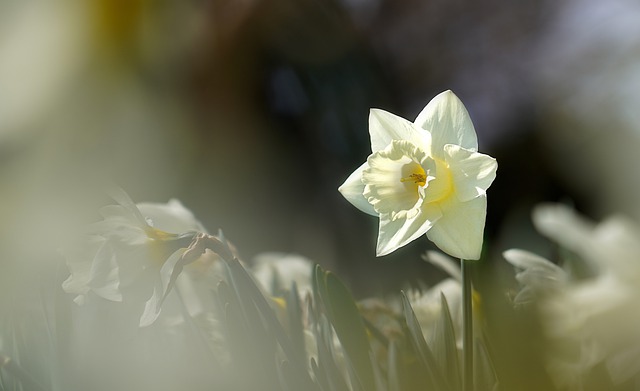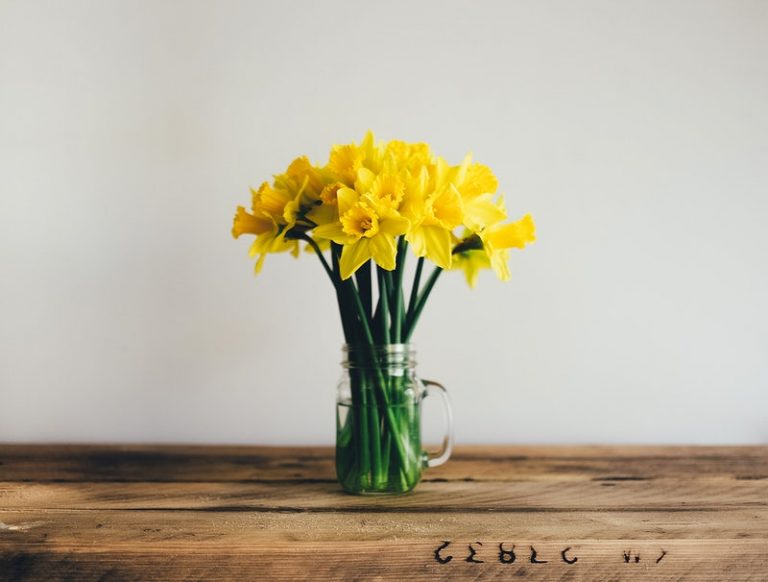Daffodils, narcissus or jonquils, whichever name you choose to call this flower, brings images of beautiful spring mornings. Of bright yellow flowers billowing in the spring breeze by the side of the road, in meadows and private gardens. Sometimes they can be seen beside tombstones in a cemetery or popping up in unexpected spaces among weeds. Wherever they may be, they are sure to fill you with instantaneous joy.
The scientific name of this flower is Narcissus pseudonarcissus. It is native to the Iberian peninsula, but now can be found far and wide, from China, to entire Europe and North Americas due to its popularity with humans. Many cultivars and varieties of this flower have been developed for commercial and horticultural purposes. There are now around 25,000 recognized varieties. Some people tend to sow them in hundreds and thousands, over the years to enjoy the spring show on their property. Their cheerful color and carefree growth habits makes them a popular choice as spring bulbs.

An interesting aspect of this plant is, it has an advantage over grazing herbivores. The entire plant is toxic, so rabbits and deer avoid them. Daffodils produce several types of toxins to deter grazing. Bundles of needle shaped calcium oxalate crystals (as found in all types of “kochu”- Araceae family of plants, widely distributed in South East Asia and Indian subcontinent) and several different types of alkaloids. One of these compounds, Galanthamine, have proved to be useful as a medicine for Alzheimer’s dementia. It is marketed as Reminyl by Shire Pharmaceuticals in the UK. [1]
The flower derives its name from the Greek mythological figure, Narcissus. Narcissus was the son of the river god Cephissus and the nymph Liriope (there is another garden plant named after Liriope). Narcissus was a hunter and was famously handsome. Many fell in love with him at first sight. However, instead of acknowledging their love, he showed contempt and disdain towards those who professed their love to him. One day when he was hunting in the woods, the nymph Echo saw and fell in love with him. She started following him. When Narcissus became aware of her, she made her advance by trying to hug him which he rejected. Echo could not come to terms with the rejection and in despair roamed around the woods till she wilted away. All that remained of her was an echo sound. When Nemesis, the goddess of retribution and revenge, learned about what happened to Echo, she decided to punish Narcissus. She led him to a pool where he saw his own reflection and fell in love with himself. He was so enamored with the reflection that he starved, and became weak. When he realized that he was in love with his own shadow he fell in despair that his love will never materialize, which led him to commit suicide. In the place where he died, yellow flowers grew. Thus, the Narcissus flowers got their name. [2]
The widespread distribution and naturalization of daffodil flowers throughout Europe is the contribution of the Roman army. Believing in the medicinal properties of the daffodil flower bulbs, they used to carry and plant wherever the Roman army went. Daffodils naturalize easily by seeds and bulbs. Not only in Europe but also in North America, a field of daffodils indicate a long-gone homestead. Settlers brought daffodil bulbs from Europe to their new homes. American daughters used to get plants and bulbs as wedding gifts to take to their new homes. [3]
It was not uncommon to find daffodil bouquets in the office fridge in the US. The American Cancer Society used to run a fundraiser called The Daffodil Days, for cancer research. People would pool money and donate. The flowers would arrive in the office and would be distributed to the donors to brighten up homes. What a wonderful way to fund cancer research. However, the fascination with these flowers is not just restricted to Europeans and Americans. Narcissus is integral to the celebrations of the Chinese New Year and the Persian New Year (Nowroz). In Persian, Narcissus is called Nargis. “Eyes like Nargis” or “Nargisi ankhein”, is a common theme of many Persian poems.

The pure response of joy that this flower elicits after the long winter is evidenced in its rich cultural and historical association with all humanity. I am sharing a Nursery Rhyme I came across when I was four years old. At that time, I had no idea what these flowers were as these were not tropical flowers but somehow, I remembered them. Later, I planted plenty of daffodils in my garden. They cheer me up every time I see them.
May Song
Spring is coming, spring is coming,
Birdies build your nest.
Weave together straw and feather,
Doing each your best.
Spring is coming, spring is coming,
Flowers are waking, too.
Pansies, lilies, daffo-dillies
Now are coming through.
Spring is coming, spring is coming,
All around is fair.
Shimmer, glimmer on the meadow,
Joy is everywhere.
Footnotes:
- Meriel Jones and Jane Pulman. Drugs from Daffodils. C&I Issue 4, 2011 https://www.soci.org/chemistry-and-industry/cni-data/2011/4/drugs-from-daffodils
- https://www.greekmythology.com/Myths/Mortals/Narcissus/narcissus.html
- Melody Rose. The History of Daffodils. March 5, 2016 https://davesgarden.com/guides/articles/the-history-of-daffodils
Sohini has been playing with dirt for as long as she can remember! Growing and taking care of things is something that nourishes her soul. She is attracted to beauty, in nature, art and in humans. She is going through life with eyes wide open. Always learning.







3 Responses
No mention of Wordsworth’s Daffodils ?
You know them already. Don’t you?
Eagerly waiting to learn more about nature